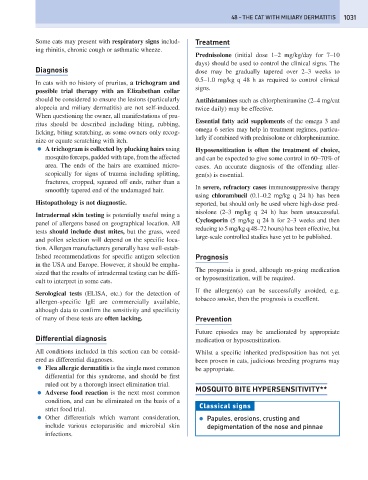Page 1039 - Problem-Based Feline Medicine
P. 1039
48 – THE CAT WITH MILIARY DERMATITIS 1031
Some cats may present with respiratory signs includ- Treatment
ing rhinitis, chronic cough or asthmatic wheeze.
Prednisolone (initial dose 1–2 mg/kg/day for 7–10
days) should be used to control the clinical signs. The
Diagnosis dose may be gradually tapered over 2–3 weeks to
0.5–1.0 mg/kg q 48 h as required to control clinical
In cats with no history of pruritus, a trichogram and
signs.
possible trial therapy with an Elizabethan collar
should be considered to ensure the lesions (particularly Antihistamines such as chlorpheniramine (2–4 mg/cat
alopecia and miliary dermatitis) are not self-induced. twice daily) may be effective.
When questioning the owner, all manifestations of pru-
Essential fatty acid supplements of the omega 3 and
ritus should be described including biting, rubbing,
omega 6 series may help in treatment regimes, particu-
licking, biting scratching, as some owners only recog-
larly if combined with prednisolone or chlorpheniramine.
nize or equate scratching with itch.
● A trichogram is collected by plucking hairs using Hyposensitization is often the treatment of choice,
mosquito forceps, padded with tape, from the affected and can be expected to give some control in 60–70% of
area. The ends of the hairs are examined micro- cases. An accurate diagnosis of the offending aller-
scopically for signs of trauma including splitting, gen(s) is essential.
fractures, cropped, squared off ends, rather than a
In severe, refractory cases immunosuppressive therapy
smoothly tapered end of the undamaged hair.
using chlorambucil (0.1–0.2 mg/kg q 24 h) has been
Histopathology is not diagnostic. reported, but should only be used where high-dose pred-
nisolone (2–3 mg/kg q 24 h) has been unsuccessful.
Intradermal skin testing is potentially useful using a
Cyclosporin (5 mg/kg q 24 h for 2–3 weeks and then
panel of allergens based on geographical location. All
reducing to 5 mg/kg q 48–72 hours) has been effective, but
tests should include dust mites, but the grass, weed
large-scale controlled studies have yet to be published.
and pollen selection will depend on the specific loca-
tion. Allergen manufacturers generally have well-estab-
lished recommendations for specific antigen selection Prognosis
in the USA and Europe. However, it should be empha-
The prognosis is good, although on-going medication
sized that the results of intradermal testing can be diffi-
or hyposensitization, will be required.
cult to interpret in some cats.
If the allergen(s) can be successfully avoided, e.g.
Serological tests (ELISA, etc.) for the detection of
tobacco smoke, then the prognosis is excellent.
allergen-specific IgE are commercially available,
although data to confirm the sensitivity and specificity
of many of these tests are often lacking. Prevention
Future episodes may be ameliorated by appropriate
Differential diagnosis medication or hyposensitization.
All conditions included in this section can be consid- Whilst a specific inherited predisposition has not yet
ered as differential diagnoses. been proven in cats, judicious breeding programs may
● Flea allergic dermatitis is the single most common be appropriate.
differential for this syndrome, and should be first
ruled out by a thorough insect elimination trial.
MOSQUITO BITE HYPERSENSITIVITY**
● Adverse food reaction is the next most common
condition, and can be eliminated on the basis of a
Classical signs
strict food trial.
● Other differentials which warrant consideration, ● Papules, erosions, crusting and
include various ectoparasitic and microbial skin depigmentation of the nose and pinnae
infections.

